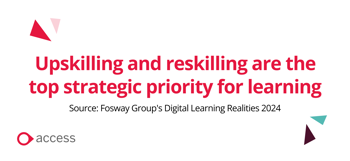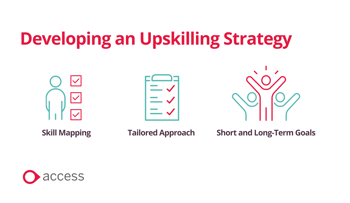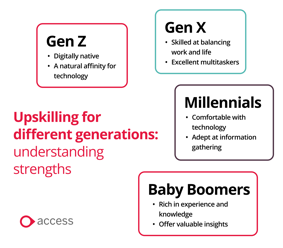How to create an Effective Upskilling Strategy Across the Employee Lifecycle
As an L&D professional, you understand the critical role of upskilling and reskilling in today's dynamic workplace. Skills development shouldn't be a one-time event; it should be a continuous process that is implemented throughout the entire employee lifecycle.
While we've previously explored what upskilling is, this article focuses on the importance of planning and implementing an effective upskilling strategy. We've also included a template to help you get started.
In this article we are going to explore:
- The growing demand for upskilling and reskilling
- Developing an upskilling strategy
- How to upskill your employees in 6 steps
- Upskilling and reskilling to help close the skills gap
- The Business Case for an Upskilling Strategy
- Leveraging Technology for Upskilling
- Upskilling for different generations
- Upskill your workforce effectively with Access Learning
The growing demand for upskilling and reskilling
There is plenty of industry discussion surrounding upskilling, spearheaded by a recent Fosway Group report revealing that upskilling and reskilling is the top strategic priority for L&D professionals. As the skills gap widens, they must invest in both role-specific skills and career development. With a staggering 7 million workers in England potentially lacking essential job skills by 2035, L&D teams must urgently prioritise and refine their upskilling strategies.
Upskilling and reskilling are powerful tools that go beyond merely filling skill gaps. They are catalysts for both employee growth and organisational success. This investment should begin on day one of a new employee's journey, with effective onboarding ensuring they have the essential skills for a strong start. The commitment to development should continue through their time with an organisation.
By prioritising employee development, companies can create a culture of continuous learning, innovation, and adaptability. This not only boosts job satisfaction and engagement but also nurtures a talent pipeline poised to embrace new challenges and drive business forward.
Moreover, the link between upskilling and career progression is undeniable. The People Profession 2023 report found that professionals who have upskilled are significantly more likely to say their career progression has exceeded their expectations. Pair this with PwC’s latest Global Workforce Hopes and Fears Survey showing that employees who say they are likely to switch employers in the next 12 months are nearly twice as likely to strongly consider opportunities to learn new skills in such decisions, and it’s clear how crucial upskilling is for employee development and retention.

Developing an upskilling strategy
A strategic approach to upskilling should:
Utilise organisation-wide skills mapping
Engaging in skills mapping across your organisation is necessary for a successful upskilling strategy. This process entails a detailed analysis of roles critical for business operations, ensuring a clear understanding of evolving skill requirements. Regular updates to these mappings are vital to reflect the dynamic nature of skills.
Recognise that each department and role have different needs
Upskilling employees (and offering training opportunities at any level) can’t work with a one-size-fits all approach. Tailoring upskilling initiatives on both a departmental and individual basis ensures that training aligns with specific job requirements, maximising its impact. From your initial roles and skills mapping, along with the current organisational level priorities and objectives, look at what departments or functions could most benefit from more support with their upskilling initiatives.
Look at current requirements alongside a long-term plan
All employees should be given the opportunity to complete skills surveys or assessments and Individual Development Plans, or IDP’s. This document is a personalised resource which helps employees to grow professionally. It will include specific steps which should be taken for them to meet the goals set out within the document. When an organisation utlitises personal development planning in this way, it helps to embed a culture of learning as an ongoing process and not just as and when it is necessary to review.

How to upskill your employees in 6 steps: Your upskilling plan template
Once you have established how you are going to approach upskilling within your organisation, you can work to introduce a framework in which upskilling individual employees can be integrated into your organisation's culture and operations. This section will guide you through a six-step process introduced by the L&D leader that can then be rolled out with supervision by line managers.
1. Define your upskilling goals
- Determine the specific skills and knowledge that your employees currently lack or could develop further for them to progress.
- Focus on the skills that are critical to achieving your business objectives and ensuring employee success.
- Prepare your workforce for change by anticipating future skill requirements based on industry trends and technological advancements.
2. Align upskilling with business objectives
- Explore how to identify the skills needed to achieve strategic goals and ensure that upskilling efforts are aligned with the overall direction of the business.
- Determine which skills are most critical to achieving your business objectives and allocate resources accordingly.
- Develop metrics to track the effectiveness of upskilling initiatives and assess their contribution to business outcomes.
3. Conduct a skills audit
- Evaluate the current skills and knowledge levels of your employees.
- Determine where there are gaps between the required skills and their current skillset.
- Leverage data within a Learning Management System to identify completion rates, stumbling blocks and areas of interest.
4. Provide personalised learning opportunities
- Leverage digital learning technology to provide a diverse range of solutions that cater to the varied learning needs across your entire workforce. This will ensure access to the most relevant learning methods.
- Provide employees with on-demand learning content across diverse subjects, so they have instant access to the learning resources they need, whenever they need them.
- Ensure training is fully accessible for those working remotely and for those with other specific accessibility needs.
5. Closely monitor progress
- Implement regular check-ins to ensure that your employees are progressing well.
- Ask for feedback to identify areas where additional support may be needed.
- Establish key performance indicators (KPIs) to measure the impact of the upskilling initiative.
6. Create a culture of ongoing learning
- Encourage a mindset of continuous learning that does not just stop when the task has been ticked off.
- Recognise and reward employees for their commitment to upskilling initiatives and the positive outcomes that come along with it.
- Build a collaborating workforce where learners feel empowered to share knowledge and seek out their own learning opportunities.
- Offer targeted learning experiences through role-specific learning paths that get pushed out whilst also providing self-serve opportunities via an extensive library of resources.
Download your own upskilling plan template today
Upskilling and reskilling to help close the skills gap
When exploring why upskilling is important for employees, it’s crucial to talk about closing the skills gap. We have discussed how to identify and close the skills gap in the workplace in detail within a previous article, noting the following takeaways:
- Bridging the skills gap requires a tailored approach, with a focus on offering diverse training and development opportunities to employees, considering various delivery methods.
- Larger businesses face challenges beyond implementing a learning management system, requiring a more comprehensive strategy to address long-term skills gaps.
- Gen Z is keen on fast career growth and believes learning is key to success, demonstrating a proactive approach to personal development.
- Employers should prioritise a balance between soft skills and hard skills, hire for attitude, and invest in strategic initiatives such as modern performance management and internal mobility to attract and retain top talent and address skills gaps effectively.
When you are looking to upskill your employees with an upskilling plan, incorporating these points will help to ensure you are training the right people on the topics and skills they will benefit from and that will help them do their jobs well.
The Business Case for an Upskilling Strategy
As with any business case, it’s important to demonstrate the value of what you are proposing. For your upskilling strategy, it will be to showcase that your workforce needs to have certain skills for them to do their job well, and this in turn will aid with both employee development and retention.
The following questions should be considered:
- What business problem are you solving with upskilling?
- What are the potential consequences of not addressing these problems?
- How will upskilling contribute to the overall business objectives?
To secure leadership buy in for upskilling your workforce, it’s crucial to quantify the return on investment of L&D. By measuring metrics such as increased employee engagement, productivity, and innovation, you can demonstrate the tangible benefits. Additionally, aligning upskilling initiatives with strategic business objectives highlights their direct contribution to organisational success.
Engaging key stakeholders early in the process can foster a shared sense of ownership and encourage their support. By positioning upskilling as a strategic imperative that drives business growth and competitiveness, you can increase the likelihood of securing the necessary resources and support.
Upskilling for different generations
When planning an upskilling strategy, it’s important to consider how different generations learn. The Work Foundation at Lancaster University found that two in five business leaders reported that a multigenerational workforce led to difficulties in communication and collaboration. This showcases the need for strategies that cater to different ages.
We have previously discussed Gen Z learning styles but it’s now time to look at every generation and how they can best be upskilled differently. For example, the rise in AI and the skills needed to utilise it are often feared and seen as the unknown, but when it comes to broadening the skillset, older generations don’t want to get left behind. While 65% Gen Z employees say they don’t currently have the right skills to meet the demands of the AI era, 50% of those in the baby boomer bracket said the same, suggesting there is a notable difference.
The 2024 LinkedIn Learning report also shed some light on how generations want to learn, with 53% of Gen Z participants agreeing that “Through learning, I can explore potential career paths at my company”, compared to 37% of other generations.
You may wish to consider the strengths of the four different generations making up this workforce, such as:
- Gen Z: Digitally native, with a natural affinity for technology
- Gen X: Skilled at balancing work and life, making them excellent multitaskers
- Millennials: Comfortable with technology and adept at information gathering
- Baby Boomers: Rich in experience and knowledge, offering valuable insights
When organisation leverage the unique qualities each generation bring to the workforce, they can ensure an upskilling strategy is both relevant and effective. Tailored learning programs, flexible training options, and mentorship opportunities can create a supportive environment where employees of all ages feel empowered to develop their skills and advance their careers.
Additionally, incorporating intergenerational collaboration projects can help break down barriers, promote knowledge sharing, and create a more cohesive workplace culture no matter the age of the learner.

Upskill your workforce effectively with Access Learning
When your organisation utilises an upskilling plan, you can make sure you are upskilling your employees and giving them the resources and skills they need to thrive. Find out how our Digital Learning Solutions can help you to retain top talent, stay compliant and plan your path to success. Why not book a personalised demo or contact us if you have any questions
Explore our Digital Learning solutions today!
There are many ways to find out more about Access Learning and how our online learning solutions can transform learning, development and compliance in your business.

Professional Development & Upskilling
Drive professional development and upskilling through Access Bookboon and access highly-engaging bite-sized content, available across 15 languages.

Struggling to track learning?
Our Learning management system (LMS) can help manage, assign and track training across your organisation.

View our eLearning library
Explore our extensive eLearning library, written by experts and designed to enhance the learning requirements of your organisation.

